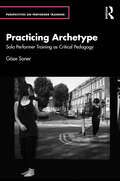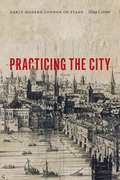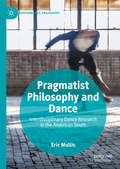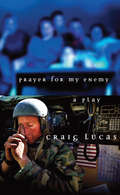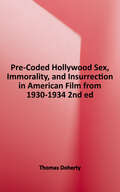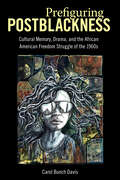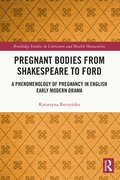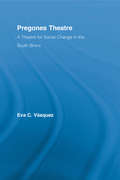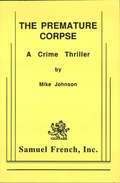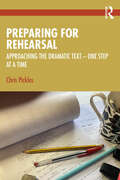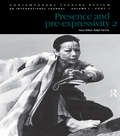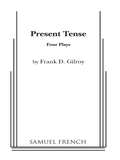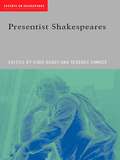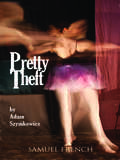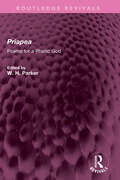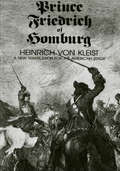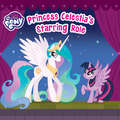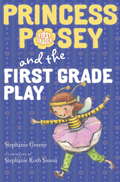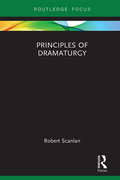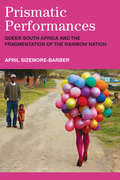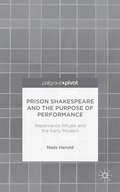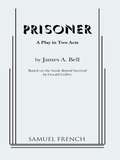- Table View
- List View
Practicing Archetype: Solo Performer Training as Critical Pedagogy (Perspectives on Performer Training)
by Göze SanerPracticing Archetype addresses performer training, specifically the self-pedagogy of actors who train solo, on their own, as an independent learning process, an opportunity for embodied research, and a form of critical pedagogy.Joining the current critical and inclusive turn in performer training, the author reconfigures the psychophysical ‘work on self’ trope as ‘encounters with the self' and turns to the genre of solo performance, including examples of solo activism from recent years, for a deeper understanding into how the self always already implicates and relates to others. The space that opens in the dialogue between performer training and solo performance is negotiated around three key themes: presence, identity, and action. Using a methodology grounded in archetypal psychology alongside liberation psychology and decolonial feminist thought, and engaging the mythological figures Echo, Odysseus, and Sisyphus, the author reviews specific archetypal images that appear in key performer training texts and revisits well-known practices through the insights drawn from solo performance. Offering audio-guided exercises traditionally used in performer training as embodied forms of inquiry into the relationships between the individual and the various collectives surrounding her, the volume proposes that solo performer training can be mobilised for multiple interrelated objectives – creative, artistic, or professional development; critical, reflective, liberatory pedagogy; and spiritual, archetypal, imaginative encounters.The book speaks to all who are engaged in performer training – students and teachers, soloists and ensembles – as well as those with an interest in embodied forms of critical pedagogy or decolonial approaches to archetype.
Practicing the City: Early Modern London on Stage
by Nina LevineIn late-sixteenth-century London, the commercial theaters undertook a novel experiment, fueling a fashion for plays that trafficked in the contemporary urban scene. But beyond the stage’s representing the everyday activities of the expanding metropolis, its unprecedented urban turn introduced a new dimension into theatrical experience, opening up a reflexive space within which an increasingly diverse population might begin to “practice” the city. In this, the London stage began to operate as a medium as well as a model for urban understanding.Practicing the City traces a range of local engagements, onstage and off, in which the city’s population came to practice new forms of urban sociability and belonging. With this practice, Levine suggests, city residents became more self-conscious about their place within the expanding metropolis and, in the process, began to experiment in new forms of collective association. Reading an array of materials, from Shakespeare and Middleton to plague bills and French-language manuals, Levine explores urban practices that push against the exclusions of civic tradition and look instead to the more fluid relations playing out in the disruptive encounters of urban plurality.
Pragmatist Philosophy and Dance: Interdisciplinary Dance Research in the American South (Performance Philosophy)
by Eric MullisThis book investigates how Pragmatist philosophy as a philosophical method contributes to the understanding and practice of interdisciplinary dance research. It uses the author's own practice-based research project, Later Rain, to illustrate this. Later Rain is a post-dramatic dance theater work that engages primarily with issues in the philosophy of religion and socio-political philosophy. It focuses on ecstatic states that arise in Appalachian charismatic Pentecostal church services, states characterized by dancing, paroxysms, shouting, and speaking in tongues (glossolalia). Research for this work is interdisciplinary as it draws on studio practice, ethnographic field work, cultural history, Pentecostal history and theology, folk aesthetics, anthropological understandings of ecstatic religious rituals, and dance history regarding acclaimed works that have sought to present aspects of religious ecstasy on stage; Doris Humphrey's The Shakers (1931), Mark Godden’s Angels in the Architecture (2012), Martha Clarke’s Angel Reapers (2015) and Ralph Lemon’s Geography trilogy (2005). The project thereby demonstrates a process model of dance philosophy, showing how philosophy and dance artistry intertwine in a specific creative process.
Prayer for My Enemy
by Craig Lucas"America the addicted. America the numb. America the war weary. America the lonely. All these countries compose the jagged terrain of this viscerally potent new play."--The Seattle Times "The very best we can hope for is to show the mess of life in such a way as to perhaps awaken our shared capacity for embracing it, in all its beauty and terror."--Craig LucasCraig Lucas "can masterfully distill a world of hurt and perplexity into complicated relations and single, pithy lines" (The Seattle Times), which is never more evident than in his latest play of public and private turmoil in today's America. Here we find the Noone family: son Billy returns from Iraq, his pregnant sister Marianne marries Billy's friend and former lover Tad, his mother Karen tries to keep her husband Austin from falling off the wagon--all while the Red Sox and Yankees battle for the 2004 pennant. With Prayer for My Enemy, Lucas returns to the dark territory he has explored with earlier works, "bringing light and craft to previously unlit corners," and illuminating the ways he is "one of the American theater's best writers" (Variety).Craig Lucas is a playwright, screenwriter, and director of both theater and film. His plays include Prelude to a Kiss, The Dying Gaul, Small Tragedy, Blue Window, God's Heart, The Singing Forest, and the book for the Tony Award-winning musical The Light in the Piazza. He is currently associate artistic director at the Intiman Theatre in Seattle.
Pre-Code Hollywood: Sex, Immorality, and Insurrection in American Cinema, 1930-1934
by Thomas DohertyThis book explores the fascinating period in American motion picture history from 1930 to 1934 when the commandments of the Production Code Administration were violated with impunity in a series of wildly unconventional films--a time when censorship was lax and Hollywood made the most of it. Though more unbridled, salacious, subversive, and just plain bizarre than what came afterward, the films of the period do indeed have the look of Hollywood cinema--but the moral terrain is so off-kilter that they seem imported from a parallel universe. In a sense, Doherty avers, the films of pre-Code Hollywood are from another universe. They lay bare what Hollywood under the Production Code attempted to cover up and push offscreen: sexual liaisons unsanctified by the laws of God or man, marriage ridiculed and redefined, ethnic lines crossed and racial barriers ignored, economic injustice exposed and political corruption assumed, vice unpunished and virtue unrewarded--in sum, pretty much the raw stuff of American culture, unvarnished and unveiled. No other book has yet sought to interpret the films and film-related meanings of the pre-Code era--what defined the period, why it ended, and what its relationship was to the country as a whole during the darkest years of the Great Depression... and afterward.
Preaching the Blues: Black Feminist Performance in Lynching Plays (Routledge Advances in Theatre & Performance Studies)
by Maisha S. AkbarPreaching the Blues: Black Feminist Performance in Lynching Plays examines several lynching plays to foreground black women’s performances as non-normative subjects who challenge white supremacist ideology. Maisha S. Akbar re-maps the study of lynching drama by examining plays that are contingent upon race-based settings in black households versus white households. She also discusses performances of lynching plays at Historically Black Colleges and Universities (HBCUs) in the South and reviews lynching plays closely tied to black school campuses. By focusing on current examples and impacts of lynching plays in the public sphere, this book grounds this historical form of theatre in the present day with depth and relevance. Of interest to scholars and students of both general Theatre and Performance Studies, and of African American Theatre and Drama, Preaching the Blues foregrounds the importance of black feminist artists in lynching culture and interdisciplinary scholarship.
Prefiguring Postblackness: Cultural Memory, Drama, and the African American Freedom Struggle of the 1960s
by Carol Bunch DavisPrefiguring Postblackness explores the tensions between cultural memory of the African American freedom struggle and representations of African American identity staged in five plays between 1959 and 1969 during the civil rights era. Through close readings of the plays, their popular and African American print media reviews, and the cultural context in which they were produced, Carol Bunch Davis shows how these representations complicate narrow ideas of blackness, which often limit the freedom struggle era to Martin Luther King's nonviolent protest and cast Malcolm X's black nationalism as undermining the civil rights movement's advances.These five plays strategically revise the rhetoric, representations, ideologies, and iconography of the African American freedom struggle, subverting its dominant narrative. This revision critiques racial uplift ideology's tenets of civic and moral virtue as a condition of African American full citizenship. The dramas also reimagine the Black Arts movement's restrictive notions of black authenticity as a condition of racial identity, and their staged representations construct a counter-narrative to cultural memory of the freedom struggle during that very era. In their use of a "postblack ethos" to enact African American subjectivity, the plays envision black identity beyond the quest for freedom, anticipating what blackness might look like when it moves beyond the struggle.The plays under discussion range from the canonical (Lorraine Hansberry's A Raisin in the Sun and Amiri Baraka's Dutchman) to celebrated, yet understudied works (Alice Childress's Wine in the Wilderness, Howard Sackler's The Great White Hope, and Charles Gordone's No Place to Be Somebody). Finally, Davis discusses recent revivals, showing how these 1960s plays shape dimensions of modern drama well beyond the decade of their creation.
Pregnant Bodies from Shakespeare to Ford: A Phenomenology of Pregnancy in English Early Modern Drama (Routledge Studies in Literature and Health Humanities)
by Katarzyna BurzyńskaThis book explores how the pregnant body is portrayed, perceived and enacted in Shakespeare’s and his contemporaries’ drama by means of a phenomenological analysis and a recourse to early modern popular medical discourse on reproduction. Phenomenology of pregnancy is a fairly new and radical body of philosophy that questions the post-Cartesian chasm of an almost autonomous reason and an enclosed and self-sufficient (male) body as foundations of identity. Early modern drama, as is argued, was written and staged at the backdrop of revolutionary changes in medicine and science where old and new theories on the embodied self-clashed. In this world where more and more men were expected to steadily grow isolated from their bodies, the pregnant body constituted an embattled contradiction. Indebted to the theories of embodiment this book offers a meticulous and detailed investigation of a plethora of pregnant characters and their “pregnant embodiment” in the pre-modern works by Shakespeare, Middleton, Webster and Ford. The analysis in each chapter argues for an indivisible link between an intensely embodied experience of pregnancy as enacted in space and identity-shaping processes resulting in a more acute sense of selfhood and agency. Despite seemingly disparate experiences of the selected heroines and the repeated attempts at containment of their “unruly” bodies, the ever transforming and “spatial” pregnant identities remain loci of embodied selfhood and agency. This book provocatively argues that fictional characters’ experience reflects tangible realities of early modern women, while often deflecting the scientific consensus on reproduction in the period.
Pregones Theatre: A Theatre for Social Change in the South Bronx (Latino Communities: Emerging Voices - Political, Social, Cultural and Legal Issues)
by Eva Cristina VásquezFirst published in 2004. Routledge is an imprint of Taylor & Francis, an informa company.
Premature Corpse
by Mike JohnsonCrime Thriller / 3m, 3f / Interior / This masterfully plotted show has so many twists and turns that we're going to tell you only the bare minimum of the story so you can enjoy the surprises when you read the script. On the surface, it's a "love triangle" tale: State's witness Evan Jorris, under a government protection program after testifying against the mob, has a wife, Francine, who along with her lover, lawyer Larry Craig contrives to do away with her husband, confident that Evan's protector, federal agent Bert Marshak, will assume, logically, that the mob did the deed, and never suspect the two of them. This deceptively simple setup, however, is not at all what it seems. By the end of the first act, you may smugly think you can second guess the play's outcome but in the second and final act, you'll ruefully discover that you not only don't know what's what you don't even know who's who! The author of that super stunner THE PERFECT MURDER has so many shocks and surprises up his insidious sleeve that you'll be downright popeyed as they explode into life, in this show that's a surefire way to dazzle and delight your audience. We'll say no more. Just get this show, quick! You and your audiences are in for the time of your lives!
Preparing for Rehearsal: Approaching the Dramatic Text – One Step at a Time
by Chris PicklesA resource for actors, directors, and writers (both professional and in training), this is a step-by-step, practical guidebook to the pre-rehearsal analysis of a script. Its aim is to de-mystify and organise the questions necessary to ask in order to prepare for a creative, imaginative and fruitful exploration of a dramatic text in the journey towards rehearsal.The language is unselfconsciously engaging and accessible, uncluttered by alienating academic vocabulary. It holds out a helping hand throughout the important and sometimes rather lonely time of preparation for rehearsal, a time of exploration usually spent without the reassuring guidance of a director or dramaturg. The volume takes the reader on a journey, chapter by chapter, from first reading of a script to arrival in the rehearsal room or film studio for the first readthrough or day of shooting. The book maps out six investigations for the actor or director, and most importantly, the order in which those explorations should be tackled. This book also forms the basis of any core text analysis module for students studying on professional acting, theatre arts, scriptwriting, media, and film or directing degrees at a university, college, or conservatoire level.A professional director, actor and writer, this guide is also a result of Chris Pickles’ many years of experience not only in running workshops for theatre professionals, but also teaching text analysis to actors and directors in training.
Presence and Pre-Expressivity 2
by Ralph YarrowThis is Volume 7, Part I of the Contemporary Theatre Review, an International Journal, with this edition focusing on Prescence and pre-expressivity. Covering topics such as Body in Mind: Exploring Pre-Expressivity; Peter Brook and Traditional Thought; Grotowski, Holiness, and the Pre-Expressive; Barba's Concepts of the Pre-Expressive and the Third Organ of the Body of the Theatre and Theories of Consciousness; Pre-Expressivity: Some Thoughts from the Rehearsal Floor.
Present Tense
by Frank D. GilroyDrama / 1m, 1f / Interior / Father peeks out the window while the doorbell rings. Mother knows it's "her" by her ring, and Father keeps watching and refusing to let "her" in. The madness mounts as they do not open the door, and the father finally spills the beans he is leaving. This is an avant garde, Beckett-like script.
Presentist Shakespeares (Accents on Shakespeare)
by Hugh Grady Terence HawkesPresentist Shakespeares is the first extended study of the principles and practice of 'presentism', a critical movement that takes account of the never-ending dialogue between past and present. In this bold and consistently thought-provoking collection of presentist readings, the contributors: argue that the ironies generated by our involvement in time are a fruitful, necessary and an unavoidable aspect of any text's being, and that presentism allows us to engage with them more fully and productively demonstrate how these ironies can function as agents of change, flowing unstoppably back into the events of the past, colouring how we perceive them and modifying our sense of what they signify show that a critic's inability to step beyond time and specifically the present does not, as has been argued elsewhere, 'contaminate' readings of Shakespeare's plays, but rather points to shades of implication suddenly available here and now within the wide range of plays examined suggest that presentism might not merely challenge or expand our sense of what Shakespeare's plays are able to tell us, but may in fact offer the only effective purchase on these texts that is available to us. Presentist criticism is an open-ended and on-going project, located at a particularly interesting and demanding juncture in modern Shakespeare studies. At this crucial point, then, Presentist Shakespeares is a compelling collection of readings by a distinguished team of authors, but it is also much more: it is a landmark, which reflects, develops and even rejoices in the intedeterminacy of the field. Contributors include: Catherine Belsey, Michael Bristol, Linda Charnes, John Drakakis, Ewan Fernie, Evelyn Gajowski, Hugh Grady, Terence Hawkes and Kiernan Ryan.
Pretty Goblins
by Beth GrahamFrom holding hands in the womb to holding each other’s hair back when they puked, twins Laura and Lizzie grew up only having each other. They couldn’t count on their practically feral mom, absent dad, or even the boys they liked. They’re polar opposites—Laura’s reserved while Lizzie’s reckless—but their shared mischievous giggles and dreams for the future kept them going. One day, Laura finds a familiar book of poems in Lizzie’s apartment and is dragged through their turbulent past. Together, the sisters relive their complicated history in an effort to make sense of the present. Framed by the beauty of a well-loved poem, this story of ferocious sisterhood, addiction, and the aftermath of trauma will leave howls echoing in your ears.
Pretty Theft
by Adam SzymkowiczDrama / Characters: 3m, 4f Pretty Theft is a play about ballerinas, boxes and the dangers of beauty. After losing her father, Allegra falls under the wing of bad girl Suzy, only to find an unexpected friendship with Joe, an autistic savant. When things take a violent turn, Allegra and Suzy escape cross country and befriend Marco, a mysterious thief who claims he cannot be caught. "Disturbing but touching...Mr. Szymkowicz writes quirky plays about contemporary topics like online dating and gender roles, but there always seems to be something - a knife, a rope, a dead body - in an unexpected place. In Pretty Theft, the undercurrent of danger goes beyond quirkiness; it's more subtle and ultimately more horrifying. The play takes place in a terrifying world where reckless people get hurt, and so do more or less innocent bystanders." -The New York Times "Szymkowicz has not only taken the notion of theft and flipped it on its head - he's taken a story about human beings at their worst and shown how we can claw our way back from the brink by finding the good within ourselves." -The Villager "Adam Szymkowicz has written a play full of interesting people...The dialogue and humor in this play are excellent...It runs a lean, intermission-less 90 minutes and is very satisfying...This would be good theater for young women not only to see but also to perform." -NYTheatre.com
Priapea: Poems for a Phallic God (Routledge Revivals)
by W. H. ParkerFirst published in 1988, Priapea is a collection of eighty Latin epigrams, English translated, that make up the corpus Priapeorum, which displays remarkable skill, artistry and wit. Their elegance of style contrasts strikingly with their indecent subject matter. The poems are mostly spoken by, or addressed to, the lewd god Priapus, famous for the size and tenseness of his erect membrum virile or phallus. A main theme is the threatened use of his formidable organ to assault obscenely any intruders that he may catch thieving, but requests and offsprings made to Priapus, and his comparison of himself with other deities, also figure prominently among the poems. This book will be of interest of literature, classical studies, and translation studies.
Prince Friedrich of Homburg: A New Translation For The American Stage
by Heinrich Von Kleist Diana Stone Peters Frederick G. PetersPrince Friedrich of Homburg is the indisputable dramatic masterpiece of Heinrich von Kleist (1777-1811), a leading figure, along with Goethe and Schiller, among early German Romantics. Available until now only in verse translation, it has been newly rendered for the American stage by Diana Stone Peters and Frederick G. Peters. A work of profound psychological insight, Prince Friedrich of Homburg probes with passionate intensity questions fundamental to “civilized” behavior. Prince Friedrich, the hero of the historic battle of Fehrbellin (1675) against the invading Swedes, receives not laurels for his victory but the sentence of death for disobeying orders in the field. Faced with certain execution, his mood swings from abject terror to high-minded exultation as first he challenges, and then accepts, the rule of law and subservience to the state. The action moves relentlessly in the near-frenzied pace characteristic of Kleist. Intended as a paean to a Prussia triumphant in the Napoleonic wars. the play was, ironically, censured and never produced in Kleist's lifetime. In our own day, Prince Friedrich of Homburg has been both denounced as a protofascist work and lauded as a supreme metaphysical disquisition. Whatever the merits of such intellectualization, it remains one of the most moving and performable plays available for the modern stage.
Princess Celestia's Starring Role (My Little Pony)
by Louise AlexanderIt's the 1,111th anniversary of when Princess Celestia first raised the sun, and Twilight Sparkle knows just how to celebrate: with a play starring Princess Celestia herself! The only problem is Princess Celestia can't act! Can Twilight Sparkle find a way to break it to her mentor and save the show?This storybook is based on an episode of My Little Pony: Friendship is Magic, as seen on Discovery Family and Netflix.© 2019 Hasbro. All Rights Reserved.
Princess Posey and the First Grade Play
by Stephanie Greene Stephanie Roth SissonEveryone's favorite first grader, Princess Posey, has to fess up to her biggest mistake yet in this eleventh book in the series!Posey's class has been learning all about bees, and when they plan to put on a play to demonstrate everything they've learned, Posey is thrilled. Posey loves a stage, and she's already got her heart set on the perfect role: the Queen Bee. But when Caitlyn is picked for the Queen Bee, Posey is crushed. Taking matters into her own hands, Posey swipes Caitlyn's special bee eraser when nobody's looking. But after she takes it, she feels worse. Maybe stealing wasn't the right thing to do--but how can she ever make things right? It takes a talk with her mom and a whole lot of courage, but Posey makes an important discovery: owning up to your mistakes is always the right thing to do.Praise for Posey:"Greene doesn't miss a step. Posey is the perfect fictional friend for any first-grade girl."—Kirkus Reviews"Greene's simple writing style and straightforward plot is ideal for advanced first graders or beginning second-grade readers."—School Library Journal
Principles of Dramaturgy (Focus on Dramaturgy)
by Robert ScanlanIn Principles of Dramaturgy, Robert Scanlan explains the invariant principles behind the construction of stage and performance events of any style or modality. This book contains all that is essential for training a professional stage director and/or dramaturg, including the "plot-bead" technique for analyzing play scripts developed by Scanlan. It details all the steps for the full implementation of "Production Dramaturgy" as it is practiced in professional theatres, and treats form and action as foundational cornerstones of all performance, rather than "story" elements – a frequent and debilitating misprision in theatre practice. Scanlan’s unique approach offers practical training that is supported by detailed diagrams and contextualized instructions, making this the missing text for classes in dramaturgy. Serving stage directors, dramaturgs, actors, designers, and playwrights, Principles of Dramaturgy is a comprehensive guide that puts the training of capable practitioners above all else.
Prismatic Performances: Queer South Africa and the Fragmentation of the Rainbow Nation (Triangulations: Lesbian/Gay/Queer Theater/Drama/Performance)
by April Sizemore-BarberAt his 1994 inauguration, South African president Nelson Mandela announced the “Rainbow Nation, at peace with itself and the world.” This national rainbow notably extended beyond the bounds of racial coexistence and reconciliation to include “sexual orientation” as a protected category in the Bill of Rights. Yet despite the promise of equality and dignity, the new government’s alliance with neoliberal interests and the devastation of the AIDS epidemic left South Africa an increasingly unequal society. Prismatic Performances focuses on the queer embodiments that both reveal and animate the gaps between South Africa’s self-image and its lived realities. It argues that performance has become a key location where contradictions inherent to South Africa’s post-apartheid identity are negotiated. The book spans 30 years of cultural production and numerous social locations and includes: a team of black lesbian soccer players who reveal and redefine the gendered and sexed limitations of racialized “Africanness;” white gay performers who use drag and gender subversion to work through questions of racial and societal transformation; black artists across the arts who have developed aesthetics that place on display their audiences’ complicity in the problem of sexual violence; and a primarily heterosexual panAfrican online soap opera fandom community who, by combining new virtual spaces with old melodramatic tropes allow for extended deliberation and new paradigms through which African same-sex relationships are acceptable. Prismatic Performances contends that when explicitly queer bodies emerge onto public stages, audiences are made intimately aware of their own bodies’ identifications and desires. As the sheen of the New South Africa began to fade, these performances revealed the inadequacy and, indeed, the violence, of the Rainbow Nation as an aspirational metaphor. Simultaneously they created space for imagining new radical configurations of belonging.
Prison Shakespeare and the Purpose of Performance: Repentance Rituals and the Early Modern
by Niels HeroldOver the last decade a number of prison theatre programs have developed to rehabilitate inmates by having them perform Shakespearean adaptations. While twentieth and twenty-first century ideas about theatre as therapy, political resistance, and popular education hold sway for many programs, this book focuses on how prison theatre today reveals certain elements of the early modern theatre that were themselves responses to cataclysmic changes in theological doctrine and religious practice. Herold reads the Shakespearean theatre at once historically and forward ("presentising"). He examines the precise dramaturgical and ideological elements of this historical theatre that are today conducive to the remarkable rehabilitative success of prison theatre programs like Shakespeare Behind Bars.
Prisoner (Bell)
by James A. BellDrama / 14m, 1f, 2c / Minimal set / Set inside the Hoa Lo prison in Hanoi, this drama provides a close up look at experiences of actual POWs in Vietnam. Navy Lieutenant Gerald Coffee was captured in North Vietnam in 1966. Prisoner follows his experiences with guards who endeavored to strip away his identity and break his will, and depicts how he finds the means to survive by communicating secretly with other prisoners. The terrors and the fleeting joys, including moments of connection and humanity between captor and captive, are brought to life on the stage. After three years of torture in captivity, Lt. Coffee is offered the ultimate temptation: he will be set free if he writes a letter to Ho Chi Minh requesting amnesty. An inspiring story of life and honor, Prisoner won Best New Play at the 1994 Kennedy Center/American College Theatre Festival.
